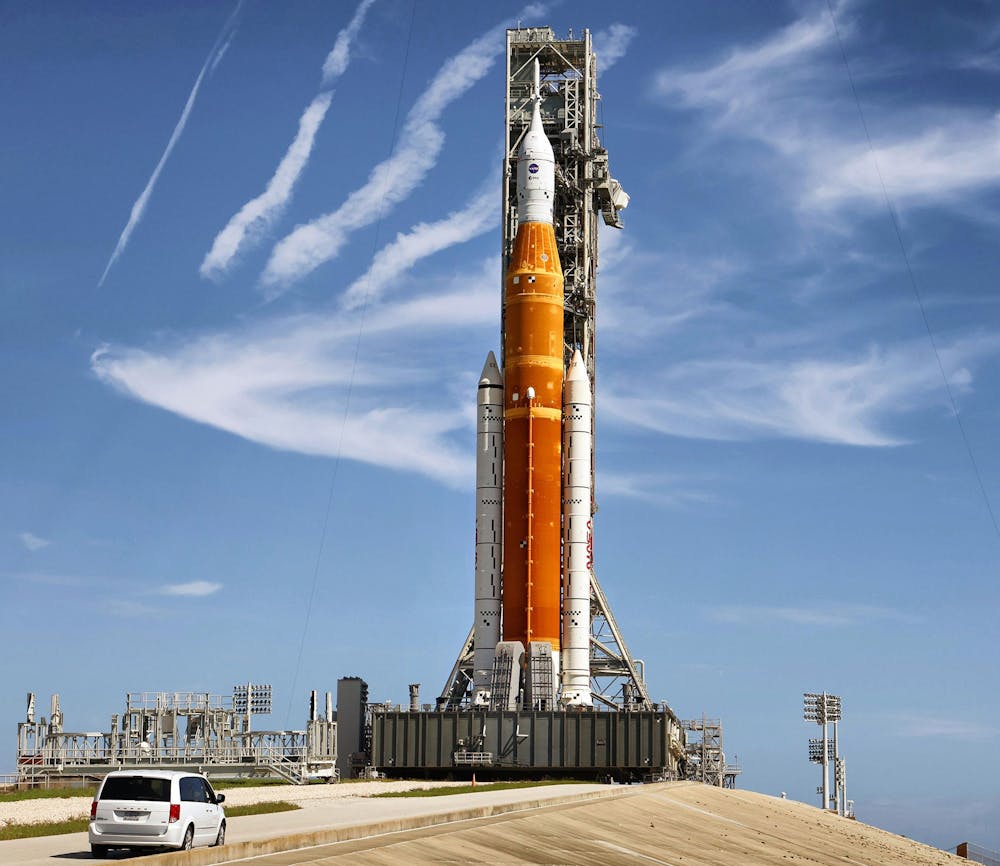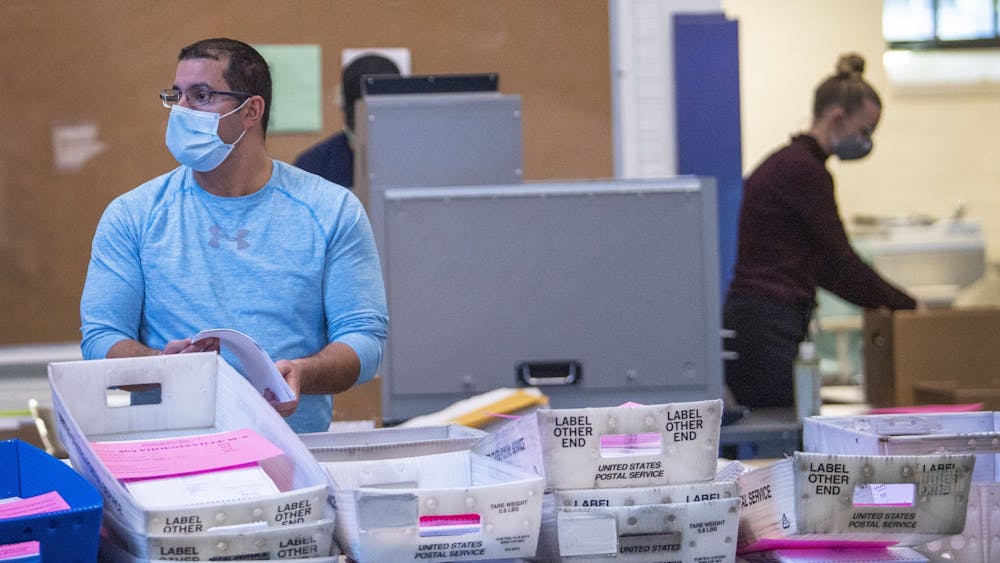Editor's Note: The Indiana Daily Student is now publishing national articles from our wire service. What does that mean? Read a letter from the editor about it here.
ORLANDO, Fla. — NASA began its tanking test of the Space Launch System core and upper stage Wednesday at Kennedy Space Center that could pave the way for the Artemis I launch to the moon next week, but a new leak in a fuel line yet again gave NASA headaches.
The test that got the go to proceed at 7:30 a.m. Eastern time at Launch Pad 39-B looks to make sure repairs to fuel lines made since a scrub on Sept. 3 can support the more than 730,000 gallons of cryogenic liquid hydrogen and liquid oxygen that needs to flow into the core stage as well as the upper Interim Cryogenic Propulsion Stage of SLS.
But a new leak in the same line that caused that scrub was detected as NASA halted liquid hydrogen fueling shortly before 10 a.m.
“They did have a detection of a hydrogen leak in the tail service mast umbilical,” said commentator Derrol Nail with NASA
Communications. “It’s in the lower portion of the rocket. They have a 7% reading of hydrogen in a cavity there where that quick disconnect line is. This is the one that was repaired.”
A quick disconnect is designed to fall off and away from the rocket when it launches.
The 7% leak is above the 4% threshold NASA has in place for cryogenic fueling limits. NASA had been loading liquid oxygen without issue since before 9 a.m., but once again liquid hydrogen, which also gave NASA issues during the first launch attempt in August as well as during wet dress rehearsals in the spring, caused a halt to the loading process.
NASA then shifted to problem solving using the same warm-up procedure it had tried several times in previous leak detections. That process brings the lines’ temperatures back up from their super cold fill temperatures: minus 423 degrees Fahrenheit for the liquid hydrogen and minus 294 degrees Fahrenheit for the liquid oxygen.
The lines are then rechilled hoping that pressure and temperature changes might close up any place that might have been the source of the leak.
The reattempt to load liquid hydrogen began after 11:30 a.m., but with a slight change in operation.
“It’s different from previous plans during the second launch attempt and that is that they’re going to drop the pressure on the storage tank to less than 5% psi — drop that as very low pressure for this operation,” Nail said. “And then as they recover flow into the tank, into the cryosphere, they’re going to very slowly, as kind and as gentle as they can to step up the pressure.”
The fix worked to some degree with operations on both cryogenic fuels up and running so that by noon, the liquid oxygen was approaching 100% of its 196,000-gallon capacity and the liquid hydrogen, at not-quite-fast-flow was above 25%, of its 538,263-gallon capacity.
NASA officials stated that after the restart, the leak topped out at only 3.4%, and teams were able to complete another planned test called the kickstart bleed, during which the liquid hydrogen is used to cool down the four RS-25 engines below the core stage. That process was among issues that led to the first launch attempt’s scrub in August because of a faulty sensor that said one of the engines wasn’t as cold as it needed to be, a requirement NASA has to thermally condition the engines so they can endure the super-cold fuel as it flows into the engines.
By 12:45 p.m., the liquid hydrogen fill process was at 68%, but was still under the normal fast-fill pressure flow normally used for tanking on launch day.
“The team discussing with the launch director the plan to go forward from here and here’s where they settled,” Nail said. “They want to gradually increase the storage tank pressure which will increase the pressure on this quick disconnect as well. It also increases the flow getting it hopefully to the fast-fill flow that would be nominal for a launch attempt. That’s the ultimate goal.”
By 1 p.m. liquid hydrogen was above 90% full, and soon after topped out so teams were in replenishment mode, during which only enough liquid hydrogen is pumped into compensate for the amount that is boiled off in the core stage.
“Some interesting data to pass along that we just learned and that is that during fast-fill operation, where the storage tank was at full pressure for loading the liquid hydrogen, the leak rate was less than half a percent,” Nail said. “Very manageable for the team here, but also at the moment has a lot of folks scratching their head on this one.”
Wednesday’s test also uncovered a failing sensor that would have triggered the shift from slow to fast fill of the liquid hydrogen. NASA teams halted liquid hydrogen loading as they sought to switch to a backup sensor, and that’s when the leak detection occurred.
“We’re getting some good news from the liquid hydrogen team in regards to the leak,” Nail said. “That is it reversed its trend where previously when pressure increased, the leak increased, but now they are seeing a trend for this particular seal that when pressure increases, it decreases. This is as engineers say, the way that it’s designed and intended to work. ... So now, both tanks of the core stage are in replenish and are stable.”
Now that the core stage is full, the plan is to open supply lines into the upper stage ICPS, which is the hardware with its own engine that will be used once SLS sends the Orion spacecraft out of Earth’s atmosphere.
The teams gave to go for ICPS tanking just before 2 p.m. Its smaller tanks hold 19,250 gallons of liquid hydrogen and 5,700 gallons of liquid oxygen.
The ICPS will push Orion into what’s known as the trans-lunar injection, sending it on its way for a multiweek mission that will see the uncrewed spacecraft travel farther out beyond the moon and bring it back home to Earth faster than any other previous human-rated spacecraft to make sure it will be safe for astronauts on future Artemis missions.
After the ICPS tanking, NASA plans to do what is called a pre-pressurization test, which will bring the core stage liquid hydrogen tank up to the pressure level that would be needed just before launch, which will allow engineers to calibrate engine conditioning that would be needed at what would be a higher flow rate of both propellants, something that would be done during the terminal count on launch day.
Teams were given a go for the pre-press test at 3:30 p.m.
“This pre-press test is critical for terminal count,” Nail said. “During terminal count at T-4 minutes and 40 seconds is when the high-flow bleed will start for a launch countdown. It will run for about 4 1/2 minutes and will get the engines to exactly the right temperature for launch. The launch team to this point have not been able to validate this procedure yet. They have the opportunity to do that now.”
The reason it has yet to be tested was because wet dress rehearsals in spring faced pressure and valve issues that did not let mission managers accomplish all of their goals. Despite that, they went ahead with launch attempts. This pad test acts essentially as another wet dress rehearsal.
A new hydrogen leak on an engine bleed line showed up during the pre-press test, but stabilized at around 4%, and mission managers had a contingency for launch to allow for it to exceed 4%, but for no more than five minutes, Nail said. The leak on the earlier line had been shut off from the SLS during the pre-press test as no incoming propellants were in play at the time.
“The launch team has achieved the pressure they were looking for,” Nail said. “It’s a tight range, but they’ve got it in spec. Big accomplishment there. ... the test is now complete.”
Now teams are refilling the core stage with the liquid hydrogen that was expelled during the pre-press test, and get the upper stage back into replenish mode, so essentially a stable set of propellant again in both the core stage and ICPS.
Tanking operations were originally expected to be complete by 3 p.m., but delays because of the leak extended that timeline.
After the most recent scrub, NASA made repairs at the launch pad, so that if Wednesday’s test works out, a potential launch attempt could happen next Tuesday.
The core stage’s engines combined with two solid rocket boosters not being tested Wednesday will combine to provide 8.8 million pounds of thrust on liftoff, which would make the SLS the most powerful rocket to have ever launched from Earth besting the Saturn V rockets used in the Apollo program.
The test was already incorporating what NASA managers called a kinder, gentler way of loading to avoid any temperature and pressure shocks that could have been the reason behind the Sept. 3 leak.
“This is part of the new operation where they’re taking it very slow with the liquid hydrogen allowing the lines to get very slowly chilled and then slow fill has gone a little slower than usual into the tank,” Nail said.
NASA still needs an OK to go from the U.S. Space Force, which controls the Eastern Range over which the rocket would launch. NASA is seeking a waiver to a rule about checking the batteries on the rocket’s flight termination system, which currently requires NASA to make sure the batteries are charged within 25 days, a process that would have required the massive 5.75 million-pound, 322-foot-tall combination of rocket, launcher and spacecraft to roll back to the Vehicle Assembly Building.
The last time the self-destruct mechanism was checked was before Aug. 16 when Artemis I last rolled to the launch pad from the VAB.
If NASA does get the waiver, it is pursuing two potential launch dates. The first is Tuesday, Sept. 27, a 70-minute window that opens at 11:37 a.m. that would fly on a nearly 40-day mission that would land back on Earth on Nov. 5. The second is Sunday, Oct. 2, a 109-minute window that opens at 2:52 p.m. and would fly for roughly a 41-day mission and land on Nov. 11.






